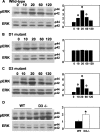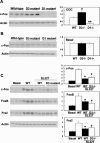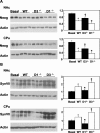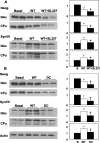Cocaine-induced intracellular signaling and gene expression are oppositely regulated by the dopamine D1 and D3 receptors
- PMID: 15056714
- PMCID: PMC6730011
- DOI: 10.1523/JNEUROSCI.0060-04.2004
Cocaine-induced intracellular signaling and gene expression are oppositely regulated by the dopamine D1 and D3 receptors
Abstract
Repeated exposure to cocaine can induce neuroadaptations in the brain. One mechanism by which persistent changes occur involves alterations in gene expression mediated by the dopamine receptors. Both the dopamine D1 and D3 receptors have been shown to mediate gene expression changes. Moreover, the D1 and D3 receptors are also coexpressed in the same neurons, particularly in the nucleus accumbens and also caudoputamen (CPu). Little is known however, whether these two receptors coordinately regulate gene expression after cocaine administration and the underlying mechanisms. We have used various gene mutant mice to address this issue. We show that extracellular signal-regulated kinase (ERK) activation and c-fos induction in the CPu in response to acute cocaine administration is mediated by the D1 receptor and inhibited by the D3 receptor. Moreover, ERK activation mediates acute cocaine-induced expression of Fos family genes, including c-fos, fosB and fra2. Interestingly, dynorphin, neogenin, and synaptotagmin VII, genes that possess cAMP-response element binding protein and AP-1 transcription complex-binding consensus sequences in their promoters, are also oppositely regulated by the D1 and D3 receptors after repeated exposure to cocaine. Furthermore, such regulation depends on proper ERK activation and c-fos function. These results suggest that the D1 and D3 receptors elicit opposite regulation of target gene expression by regulating ERK activation and c-fos induction after acute and chronic cocaine treatment.
Figures









Similar articles
-
Opposite regulation of cocaine-induced intracellular signaling and gene expression by dopamine D1 and D3 receptors.Ann N Y Acad Sci. 2006 Aug;1074:1-12. doi: 10.1196/annals.1369.001. Ann N Y Acad Sci. 2006. PMID: 17105899
-
The dopamine D1 receptor is a critical mediator for cocaine-induced gene expression.J Neurochem. 2002 Sep;82(6):1453-64. doi: 10.1046/j.1471-4159.2002.01089.x. J Neurochem. 2002. PMID: 12354293
-
Dopamine D(1) and D(3) receptors oppositely regulate NMDA- and cocaine-induced MAPK signaling via NMDA receptor phosphorylation.J Neurochem. 2007 Oct;103(2):840-8. doi: 10.1111/j.1471-4159.2007.04840.x. J Neurochem. 2007. PMID: 17897358
-
Functional implications of multiple dopamine receptor subtypes: the D1/D3 receptor coexistence.Brain Res Brain Res Rev. 1998 May;26(2-3):236-42. doi: 10.1016/s0165-0173(97)00046-5. Brain Res Brain Res Rev. 1998. PMID: 9651537 Review.
-
NMDA and D1 receptors mediate induction of c-fos and junB genes in striatum following morphine administration: implications for studies of memory.Behav Brain Res. 1995 Jan 23;66(1-2):225-30. doi: 10.1016/0166-4328(94)00146-7. Behav Brain Res. 1995. PMID: 7755894 Review.
Cited by
-
Behavioral sensitization, alternative splicing, and d3 dopamine receptor-mediated inhibitory function.Neuropsychopharmacology. 2006 Nov;31(11):2368-75. doi: 10.1038/sj.npp.1301163. Epub 2006 Jul 19. Neuropsychopharmacology. 2006. PMID: 16855531 Free PMC article. Review.
-
What is the Degree of Segregation between Striatonigral and Striatopallidal Projections?Front Neuroanat. 2010 Oct 7;4:136. doi: 10.3389/fnana.2010.00136. eCollection 2010. Front Neuroanat. 2010. PMID: 20953289 Free PMC article.
-
Identification of key genes and therapeutic drugs for cocaine addiction using integrated bioinformatics analysis.Front Neurosci. 2023 Jul 4;17:1201897. doi: 10.3389/fnins.2023.1201897. eCollection 2023. Front Neurosci. 2023. PMID: 37469839 Free PMC article.
-
Striatal signal transduction and drug addiction.Front Neuroanat. 2011 Sep 20;5:60. doi: 10.3389/fnana.2011.00060. eCollection 2011. Front Neuroanat. 2011. PMID: 21960960 Free PMC article.
-
Nicotinic α7 receptors on cholinergic neurons in the striatum mediate cocaine-reinforcement, but not food reward.Front Mol Neurosci. 2025 Jan 21;17:1418686. doi: 10.3389/fnmol.2024.1418686. eCollection 2024. Front Mol Neurosci. 2025. PMID: 39906479 Free PMC article.
References
-
- Adams JP, Sweatt JD (2002) Molecular psychology: roles for the ERK MAP kinase cascade in memory. Annu Rev Pharmacol Toxicol 42: 135–163. - PubMed
-
- Caine SB, Gabriel KI, Zhang J, Xu M (2002) Decreased cocaine self-administration in dopamine D-1 receptor knockout mice. Drug Alcohol Depend 66: S25.
Publication types
MeSH terms
Substances
Grants and funding
LinkOut - more resources
Full Text Sources
Other Literature Sources
Molecular Biology Databases
Miscellaneous
